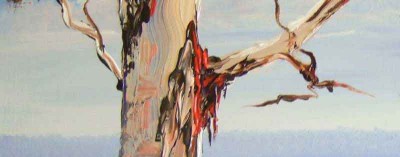About Wet on Wet Painting in Oil or Acrylic.
What is wet on wet painting?
You can try the techniques in oils or acrylics.
The idea is to paint a picture in one sitting.
The paint can be applied before the under paint dries.
You might paint a sky; then while it is still wet, paint a tree over that sky.
Blending colors is easy with the wet on wet technique.
Place one color onto your canvas, then add other colors which will be mixed or ‘blended’ on the canvas with the brush or knife to the desired tone.
This is a very handy method of blending the sky from dark above to pale in the distance.
Or blending water from light to dark. (see short video)
What is wet on wet painting?
It means you simply paint over wet paint.
 Typical example of wet on wet in acrylic color.
Typical example of wet on wet in acrylic color.
Speed Painting
I call my style of painting ‘Speed Painting’ but it is simply a wet on wet, loose method of painting.
It became my style of painting while demonstrating in shopping centers and festivals around Australia.
To hold the attention of the audience I needed to paint fast.
If I dropped my brush or stopped to squeeze paint from a tube, half my audience would go back to their shopping.
But if I was skillful I could hold the crowd for a complete painting. Often I could sell or auction that painting before it dried. (One day I must show you how to package a wet painting).
I believe many old masters used the these techniques, see Claud Monet
Look closely at his brushstrokes and you will see the colors are blended in a way that shows they were put down on top of each other and not placed side by side as done in some traditional styles of painting.
Traditional painting style.
The ‘traditional’ method of painting is still taught by some art teachers and institutions.
This usually involves sketching the subject then painting in the different items in accordance with their color or tone, that being the darkest tones first. (How boring)
Often the sky would be added last and each color, and tone of that color, would be mixed on the palette. (So you build your painting from darks to lights).
This also involved waiting for each color to dry before adding the next.
A very slow process when using oils. On large murals it can be wise to roughly paint in the dark areas first so as to not waste paint by putting the sky down under the mountains etc.
Very useful information presented in a clear, engaging way.